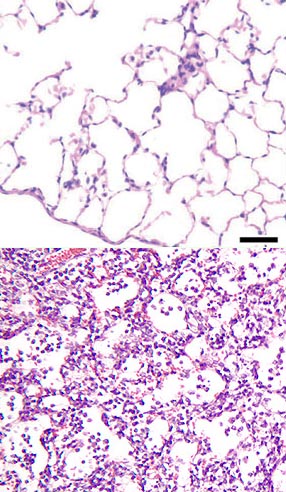Pneumonia pathophysiology: Difference between revisions
Jump to navigation
Jump to search
Kashish Goel (talk | contribs) No edit summary |
Kashish Goel (talk | contribs) No edit summary |
||
| Line 1: | Line 1: | ||
{{#widget:SchemaSnippet}} | |||
The symptoms of infectious pneumonia are caused by the invasion of the lungs by [[microorganism]]s and by the [[immune system]]'s response to the infection. Although more than one hundred strains of microorganism can cause pneumonia, only a few are responsible for most cases. The most common causes of pneumonia are [[virus]]es and [[bacteria]]. Less common causes of infectious pneumonia are [[fungi]] and [[parasites]]. The detailed pathophysiology regarding each of these etiologic organisms has been detailed under the respective chapters. | The symptoms of infectious pneumonia are caused by the invasion of the lungs by [[microorganism]]s and by the [[immune system]]'s response to the infection. Although more than one hundred strains of microorganism can cause pneumonia, only a few are responsible for most cases. The most common causes of pneumonia are [[virus]]es and [[bacteria]]. Less common causes of infectious pneumonia are [[fungi]] and [[parasites]]. The detailed pathophysiology regarding each of these etiologic organisms has been detailed under the respective chapters. | ||
[[Image:Pneumonia alveolus.jpg|200px|''Upper panel'' shows a normal lung under a microscope. The white spaces are [[alveoli]] that contain air.''Lower panel'' shows a lung with pneumonia under a microscope. The alveoli are filled with inflammation and debris.]] | [[Image:Pneumonia alveolus.jpg|200px|''Upper panel'' shows a normal lung under a microscope. The white spaces are [[alveoli]] that contain air.''Lower panel'' shows a lung with pneumonia under a microscope. The alveoli are filled with inflammation and debris.]] | ||
Revision as of 15:58, 10 May 2012
The symptoms of infectious pneumonia are caused by the invasion of the lungs by microorganisms and by the immune system's response to the infection. Although more than one hundred strains of microorganism can cause pneumonia, only a few are responsible for most cases. The most common causes of pneumonia are viruses and bacteria. Less common causes of infectious pneumonia are fungi and parasites. The detailed pathophysiology regarding each of these etiologic organisms has been detailed under the respective chapters.
Histopathological Findings
Lobar pneumonia
{{#ev:youtube|dxXrxYIXbL8}}
Pneumocystis pneumonia
{{#ev:youtube|KfF_pPUjR8o}}
{{#ev:youtube|zSdK_yWe_S4}}
Aspiration Pneumonia
{{#ev:youtube|bTqgAfQv0p4}}
Aspiration pneumonia, infant
{{#ev:youtube|RXnnEuEZ0BY}}
Desquamative interstitial pneumonia
{{#ev:youtube|G0TFmAAYjWU}}
Legionella pneumonia
{{#ev:youtube|BDWEnPilfIQ}}
Measles pneumonia
{{#ev:youtube|v80kA_dt6EE}}
Abscess, bronchopneumonia
{{#ev:youtube|wO2x7O2KEZY}}
